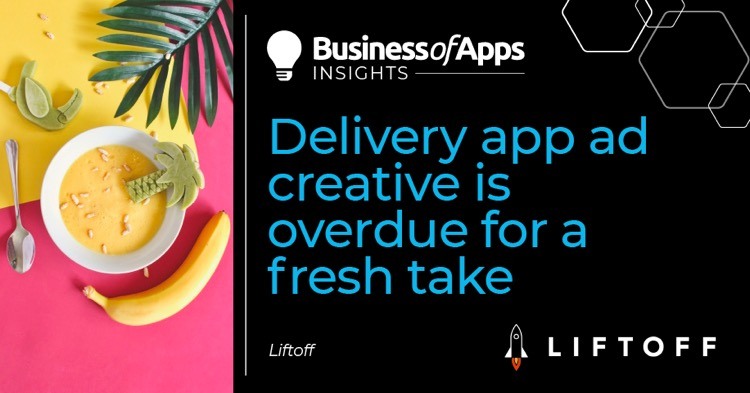When it comes to growth, few app categories have enjoyed a golden age on par with what e-commerce and delivery apps underwent as two years of pandemic lockdowns hammered home the value of affordable, at-will, socially distant delivery. Today, no one would argue that apps like Instacart or DoorDash aren’t meeting a very real market demand that will likely outlive the moment responsible for their stratospheric success.
But just as even the tastiest meals eaten often can start to feel stale without the occasional variety to shake things up, so too are ad creative strategies in danger of feeling too similar, the once-novel prospect of instant gratification becoming overly familiar. With lockdowns lifting and life returning to something resembling the pre-pandemic status quo, it’s time for delivery app marketing creatives to step into the next era of their success.
The pandemic hurled the category several years forward on the adoption curve, blowing through market education in record time and dropping it squarely into a fight for brand loyalty. Marketing teams must begin taking decisive action towards differentiation. Whichever apps acknowledge this reality and bring a fresh take to the table are poised to win big.
A commoditized category
The joy of pressing a few buttons on an app and retrieving steaming hot dim sum from your porch half an hour later cannot be overstated. That being said, it’s no longer unique. After two years of delivery-heavy lockdowns, everyone knows how rapid delivery apps work and what value they offer. DoorDash was downloaded 39 million times in 2020 alone, and revenue from the rapid delivery app category overall more than quadrupled from $1.1 billion in 2020 to $4.7 billion in 2021.
When advertisers can no longer sell on a unique value proposition, it’s time to start selling on brand.
Standing apart on familiar ground
Do you prefer Coke or Pepsi? Nike or Adidas? Most of us have a strong preference for one or the other, despite the fact that their products have more similarities than differences. Which one we prefer, whether we’re aware of it or not, ultimately comes down to branding. The brand that makes a stronger emotional connection with you first, and continues to nurture that connection, wins a customer – often for life.
What does refocusing on brand identity look like for the app world? We’ve already seen one prominent example, as Lyft ran a series of ads targeting Uber’s allegedly poor business ethics through 2016 and 2017. While both apps offer a nearly identical value proposition of gig-based rideshare services, Lyft has positioned itself as the scrappy “good guy” to set its brand apart, helping to keep it relevant despite years of trailing Uber’s market share.
Creative decisions make the difference, but even if you’re working on a cross-media campaign where mobile marketers may not have as much control, you still have access to at least one particularly promising way to set your advertising apart.
Invest in novel ad experiences
Here’s something interesting I’ve noticed in my work at Liftoff & Vungle Creative Studio: All of our most successful ads are playables, and not just for games. That isn’t just the case for us either, as Tapjoy’s Modern Mobile Gamer 2022 report cites playables as one of the top three rewarded ad types — rewarded in this case meaning people are choosing to watch your advertisement, not just passively watching as it runs between levels.
So what does making a playable ad look like for a delivery brand? Let’s say you have an imperative from upstairs to create mobile ads to tie in with a big, multi-channel ad campaign. Its content may or may not focus on differentiating your brand from the rest of the pack, but delivering it as a playable ad can still set you apart regardless.
Adding that extra element of interactivity makes a huge difference, all while preserving the core message of your broader, multi-channel campaign. You can take a ton of different approaches to making a playable eCommerce ad, but these are the two of the most successful ways we’ve seen. You can give your audience…
- The choice of what to see: Playable mobile ads can let users drill down closer to their interests — say an upfront choice to watch an advertisement for apparel or electronics, in the case of an eCommerce platform that sells both.
- Or the choice of how to see it: Specially formatted players let users skip between clips and find their own take on your story, giving them more choice and an experience that’s familiar for anybody who’s scrolled through Instagram Stories.
This is only one potential path forward for delivery brands who want to use advertising to stand out in the days after lockdown, but it’s one we have a lot of confidence in. Whatever path forward you choose, remember: it pays to be bold.












